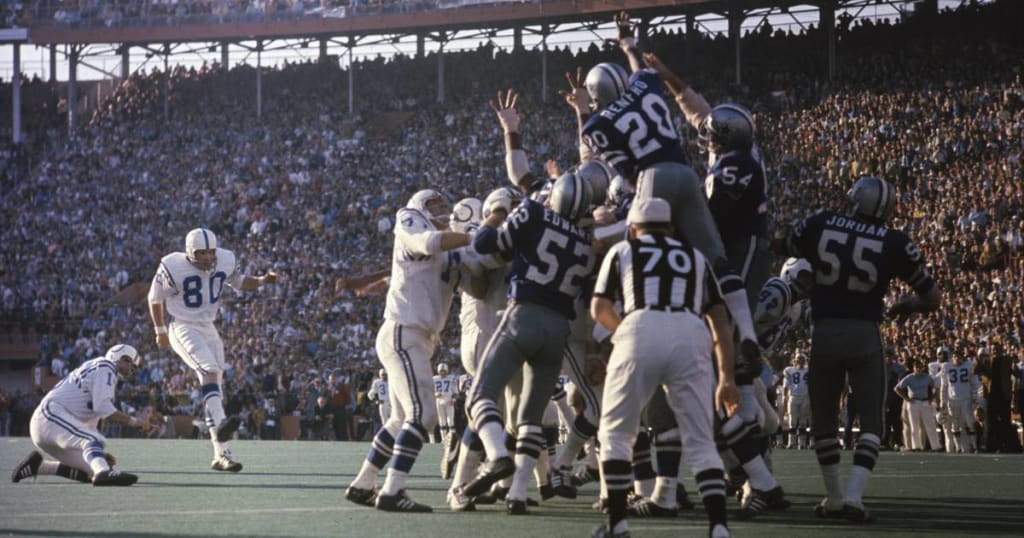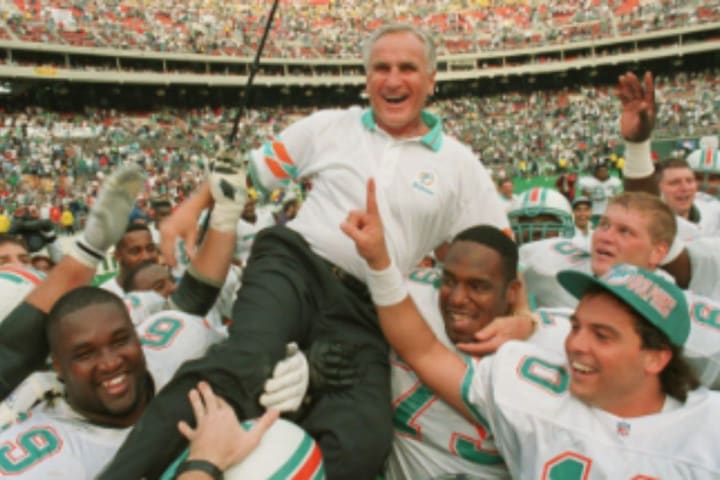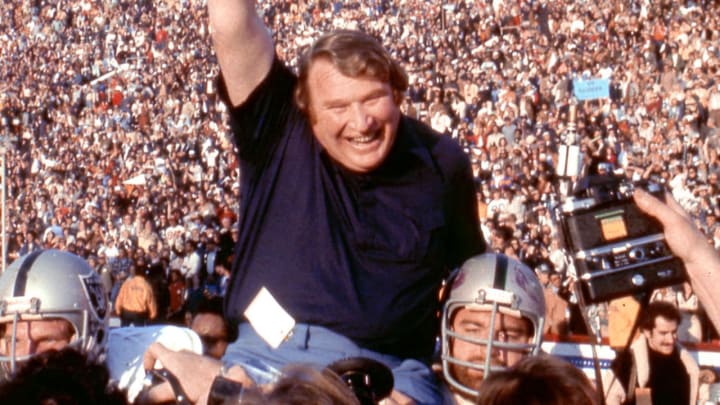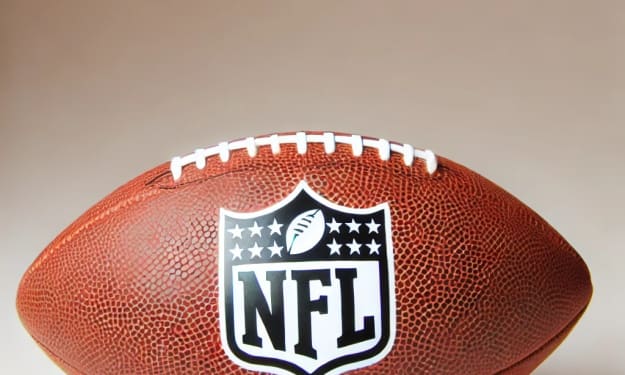History of the NFL Playoffs (Part III: The Merger - 1970-1977)
A new-look NFL leads to the early stages of the current playoff format

In 1960, a new league debuted to rival the National Football League, as Lamar Hunt's American Football League served as a formidable foe to the longer standing NFL. Throughout the entire decade, each league had their set of teams and crowned their champions, but the 1966 saw the leagues decide to have their champions play against each other to crown an overall World Champion in pro football. The first-ever AFL-NFL World Championship Game was played on January 15, 1967 and was won by the NFL's Green Bay Packers over the AFL's Kansas City Chiefs. The Packers won the first two games, while the AFL's New York Jets and the aforementioned Chiefs won the next two.
The creation of the interleague World Championship Game was the centerpiece of the early stages of an eventual merger, which finally took place during the 1970 offseason. At the time that the 1969 season ended, the NFL had 16 teams, while the AFL had just 10 teams. The plan was to place the 26 franchises into separate conferences, but in order to make them even, three NFL teams had to be placed with the 10 AFL teams. The three NFL teams who moved ended up being the Baltimore Colts, the Cleveland Browns, and the Pittsburgh Steelers, and those three, along with the 10 AFL teams, formed the American Football Conference (AFC). The 13 remaining NFL teams formed the National Football Conference (NFC).
Each of the conferences were divided into three divisions: East, Central, and West. The AFC East consisted of the Baltimore Colts, the Boston (later New England since 1971) Patriots, the Buffalo Bills, the Miami Dolphins, and the New York Jets. The AFC Central included the Cincinnati Bengals, the Cleveland Browns, the Houston Oilers, and the Pittsburgh Steelers, while the AFC West consisted of the Denver Broncos, the Kansas City Chiefs, the Oakland Raiders, and the San Diego Chargers (similar to the current AFC West).
The NFC East included the Dallas Cowboys, the New York Giants, the Philadelphia Eagles, the St. Louis Cardinals, and Washington. The NFC Central featured the Chicago Bears, the Detroit Lions, the Green Bay Packers, and the Minnesota Vikings. Finally, the geographically incorrect NFC West featured the Atlanta Falcons, the Los Angeles Rams, the New Orleans Saints, and the San Francisco 49ers.
Regarding the playoff format, eight teams qualified for the NFL's postseason. Each conference sent the winners of the East, Central, and West into the playoffs, along with Wild Card team--the best second place team in each conference. The newly formed NFL playoffs consisted of three rounds, with the opening round being the Divisional Playoff. The Divisional Playoff usually pitted the Wild Card against the top seed in the conference, while the other two teams faced each other. However, if the top seed and the Wild Card were in the same division, they could not face each other, and that would result in the Wild Card facing the #2 team, while #1 faced #3. This is the exact format that MLB would later use beginning in 1995.
All six of the division races were pretty close in 1970. The division champions in 1970 were as follows: Colts (East), Bengals (Central), and Raiders (West) from the AFC; Cowboys (East), Vikings (Central), and 49ers (West) from the NFC. The Wild Cards were the Dolphins (AFC) and Lions (NFC). All of the margins were by tw0 games or less, with the Vikings' two game margin being the largest. The #1 seeds were the Colts and Vikings, but despite my uses of the phrase "#1 seed," the NFL didn't really seed teams. Home field was determined by a yearly rotation back then, which resulted in some teams with better records actually playing on the road in some cases. As for 1970, the Raiders and Colts won their AFC Divisional Playoff games, while the NFC Divisional Playoff games were won by the Cowboys and 49ers. The Cowboys won the NFC Championship over the 49ers, 17-10, while the Colts defeated the Raiders, 27-17, in the AFC Championship.
The Cowboys and Colts ended up facing each other in Super Bowl V, the first game to have the "Super Bowl" name, with the previous four games being renamed as such retroactively. Super Bowl V took place on January 17, 1971, and is remembered as the infamous "Stupor Bowl," as the game was riddled with so many miscues and turnovers, with the Colts committing seven of them. Despite this, Baltimore did win the big game, 16-13, over the Cowboys, though the MVP was Dallas' Chuck Howley--the only time that the Super Bowl MVP was awarded to a member of the losing team.

Dallas would win their first Super Bowl a year later over the Miami Dolphins, who decided to get their own payback by never losing on the following year. Yes, this early stage of the modern NFL included those Miami Dolphins, the famous 1972 team. The Dolphins ran the proverbial table and went 14-0, and again, this is where the flaw in the format comes in. The other division winners in the AFC were the Steelers and Raiders, while the Browns were the Wild Card. The NFC's playoff teams that year: Washington (East), the Packers (Central), the 49ers (West), and the Cowboys (Wild Card). Despite Miami's unbeaten record, they played in the lesser known AFC Divisional Playoff, a 20-14 win over the Browns, while in Pittsburgh, a random pass that was supposed to be intercepted, ended up bouncing into the hands of Franco Harris. There's a name for that catch that's been uttered many times in the last half century.
So the Dolphins and Steelers faced each other in the AFC Championship, and because of the yearly rotation deciding home field, the unbeaten Dolphins actually had to go to Pittsburgh. Lack of home field aside, the Dolphins won, 21-17, in Three Rivers, and they would defeat Washington, 14-7, in Super Bowl VII to complete their perfect season.
1972 was also the year that ties counted in a team's win percentage; for example, that year's Raiders finished 10-3-1. Before that year, they would be seen as just 10-3, which is a percentage of .769, but with the tie being considered half win/half loss, that gave the Raiders an even .750 win percentage. 1974 saw the debut of sudden-death overtime in the NFL, which was instilled to reduce the number of ties. Despite this, the Steelers and Broncos played to a tie in the first OT game played, and the latter finished 10-3-1 that season. The Steelers defeated the Wild Card Bills in the Divisional Playoff, and the West champion Raiders in the AFC Championship to reach Super Bowl IX, which they won, 16-6, over the Minnesota Vikings--their first Super Bowl Championship.
It was in 1975 that playoff teams were finally seeded, and in that season, the defending champion Steelers emerged as the AFC's first official #1 seed with a 12-2 record. The Raiders won the West at 11-3 and finished at #2, while the East saw the Colts and Dolphins tied at 10-4, with Baltimore's head-to-head sweep over Miami giving them the East. The 11-3 Bengals served as the Wild Card, meaning that they would face the Raiders in the Divisional Playoff. In the NFC, the Vikings and Rams each won their divisions at 12-2, but a points system tiebreaker would give the #1 seed to Minnesota. The St. Louis Cardinals won the East at 11-3 and were given the #3 seed, while the Wild Card spot went to the 10-4 Dallas Cowboys.
Pittsburgh and Oakland's wins in the Divisional Playoff set up another AFC Championship matchup between the clubs, with the Steelers again winning. In the NFC, the Wild Card Cowboys upset the Vikings (Divisional Playoff) and the Rams (NFC Championship) to reach the Super Bowl for the third time in franchise history. Super Bowl X saw the Steelers win, 21-17, over the Cowboys at Miami's Orange Bowl.

1976 saw the addition of the Seattle Seahawks and the Tampa Bay Buccaneers to the NFL, with the latter team being on the worst end of history with their 0-14 season. That year was a big one for the Oakland Raiders, and one man in particular: John Madden. Madden was, is, and always will be remembered as one of the greatest head coaches in NFL history, but the amazing thing: he was dubbed as a coach who couldn't win the big one for years. Madden had great seasons with the Raiders, but was often snakebit--usually by the Steelers. In 1976, the Raiders had an amazing season: 13-1, the best record in the entire league. Oakland edged the Wild Card Patriots in the Divisional Playoff, and in the AFC Championship, Madden's Raiders finally got one over on the Steelers, winning 24-7 to reach the Super Bowl for the first time in nine years. The Raiders defeated the Minnesota Vikings, 32-14, in Super Bowl XI, giving the iconic Madden his lone championship in a very stellar career.
1977 was the final year of this eight-team playoff format, and the playoff teams were as follows. In the AFC, the Denver Broncos captured the West and the #1 seed, the Baltimore Colts won the East via tiebreaker over the Miami Dolphins, the Pittsburgh Steelers won a weak Central, and the defending champion Oakland Raiders were the Wild Card. In the NFC, the Dallas Cowboys took the #1 seed and the East, while the Los Angeles Rams won the West. The Central saw the Minnesota Vikings and the Chicago Bears finish tied for the lead, with Minnesota taking the division via point differential in their meetings with the Bears, who took the Wild Card via the net points in conference games edge.
In the Divisional Playoff, the AFC games featured a rare double overtime outing, as the Raiders defeated the Colts, 37-31, while the Broncos won, 34-21, over the Steelers. The NFC games saw the Cowboys win easily over the Bears (37-7), while the Vikings upset the Rams, 14-7. Both Super Bowl XI teams were knocked off in the Conference Championship; the Broncos edged the Raiders, 20-17, while the Cowboys won 23-6 over the Vikings. In Super Bowl XII on January 15, 1978, the Cowboys defeated the Broncos, 27-10. That year was the last to have a 14-game season, and again, it was the last to feature an eight-team playoff format, as the following year would add an additional team per conference, as well as a new round.
If you like this story, click the heart and the subscribe button, and feel free to comment below! Tips and pledges would be greatly appreciated, but only if you want to do so!
About the Creator
Enjoyed the story? Support the Creator.
Subscribe for free to receive all their stories in your feed. You could also pledge your support or give them a one-off tip, letting them know you appreciate their work.






Comments
There are no comments for this story
Be the first to respond and start the conversation.